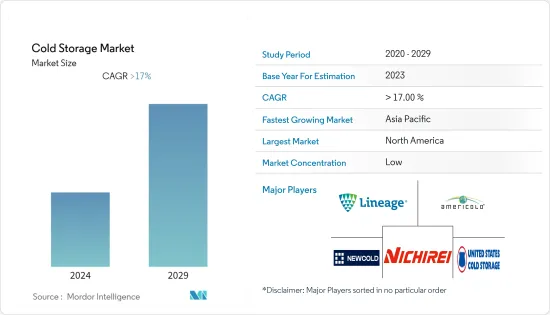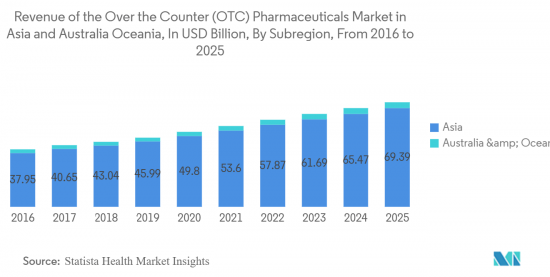 |
市场调查报告书
商品编码
1408369
冷库:市场占有率分析、产业趋势与统计、2024年至2029年成长预测Cold Storage - Market Share Analysis, Industry Trends & Statistics, Growth Forecasts 2024 - 2029 |
||||||
※ 本网页内容可能与最新版本有所差异。详细情况请与我们联繫。
预计2024年,全球冷库市场规模将达到1,902.4亿美元,预测期内复合年增长率为17%。
市场受益于对温度敏感产品生产和供应的严格监管。

主要亮点
- 这一市场的扩大与商业和工业组织对冷库的需求不断增加以及监管合规性的要求有关。大部分扩张将出现在印度、中国、巴西、印尼和墨西哥等新兴经济体。
- 根据冷库产业统计,53%的企业希望增加冷库容量。对食品和药品的需求不断增长以及对安全性的日益重视正在推动对冷藏空间的需求。
- 2022年,冷冻品类引领市场,约占全球销售额的77.3%。印度和中国等新兴国家冷冻食品消费的增加尤其推动了冷冻食品产业的发展。此类仓库的储存温度保持在 -10 至 20 F 之间。这里储存冷冻蔬菜、水果、鱼、肉、鱼贝类等。
- 缺乏支持低温运输的必要基础设施预计将成为寻求在新兴国家发展的公司的主要障碍。此外,交通枢纽和港口的冷冻拖车没有电源连接可能会阻碍这些地区的工业扩张。 COVID-19 已导致世界许多地区关闭和旅行限制,并影响了许多行业的供应链。 COVID-19 的影响对市场产生了重大影响。
冷库市场趋势
食品药品进出口快速成长
由于进出口的增加,冷库的需求迅速增加。由于全球贸易的增加以及对安全储存基础设施的需求,冷储存市场正在蓬勃发展。
印度占全球药品和医疗产品市场的5.92%。医药产品和生技药品占印度出口的大部分(73.31%),其次是医药中间体和原料药。 2021-22年,印度出口药品价值246.2亿美元,与前一年同期比较成长2%。 2020-2021年出口额为244亿美元,与前一年同期比较增长18%。
2022年3月,印度出口医药产品价值24亿美元,比2022年2月的19.7亿美元成长23%。美国、英国、南非、俄罗斯和奈及利亚是印度前五名出口目的地。
2022年12月,我国药品出口总额9.9亿美元,进口总额32.9亿美元,贸易负亏损23亿美元。 2021年12月至2022年12月,我国药品出口由40.3亿美元下降至9.9亿美元,下降30.4亿美元(-75.4%);进口由37.1亿美元下降至9.9亿美元,下降4.23亿美元(- 11.4%)。 )增至32.9亿美元。

可再生冷冻技术开闢新的市场机会
冷冻是成长最快的能源使用,但它也是当今最重要的能源讨论盲点之一。冷却需求的增加给电力基础设施带来了压力,并增加了一些国家的排放。欧盟委员会的供暖和製冷战略确定了脱碳製冷的两个重要领域,以便在 2050 年实现欧盟的气候变迁目标:「增加再生能源的比例」和「排放工业排放」。它列出了以下措施: “再利用产生的能源废弃物。”因此,开发和部署能够灵活「吸收」可再生能源和废热、将其「转换」为冷能并储存以快速响应最终用户需求的新技术非常重要。
太阳能冷藏系统可减少约 80% 的采后损失,并将生鲜食品的保质期从 2 天延长至 21 天。
还有一些冷却系统使用氨 (NH3) 或二氧化碳 (CO2) 等天然冷媒从现场收集热量并启动冷链过程。此外,即时负载监控可让您收集位置、温度、湿度、二氧化碳水平和开门等变数的资料,以便更好地控制。
提高监控和控製低温运输的能力,可以在关键变数超出品管设定范围时及时采取纠正措施,从而创造避免或减少损失的机会。
基于5G(无所不在)物联网的智慧型系统是低温运输物流设计中的新兴技术。物联网凭藉其技术优势,正朝向物流领域渗透,并取代其原有的工业形态。这为批发商和零售商做出物流决策提供了坚实的基础,对于提高整个低温运输的物流效率具有重要的应用价值。
冷库产业概况
市场有些分散,有各种各样的区域参与企业。这些市场参与企业寻求透过投资、合作、收购和合併等技术来增加市场占有率。公司也投资于新产品开发。此外,我们致力于保持有竞争力的价格。 Lineage Logistics Holdings、NewCold、Cloverleaf Cold Storage、Burris Logistics 和 Americold Logistics LLC 是市场的主要参与企业。
Americold Logistics LLC 还计划透过收购全球第四大、欧洲第三大冷藏仓库营运商 Agro Merchants Group 来扩大其在欧洲、南美、美国和澳洲的业务。
其他福利:
- Excel 格式的市场预测 (ME) 表
- 3 个月的分析师支持
目录
第一章简介
- 研究成果
- 研究场所
- 调查范围
第二章调查方法
第三章执行摘要
第四章市场动态与洞察
- 目前的市场状况
- 市场动态
- 促进因素
- 抑制因素
- 机会
- 价值链/供应链分析
- 行业法规政策
- 仓储市场的整体趋势
- 物流领域技术发展
- 产业吸引力-波特五力分析
- 供应商的议价能力
- 消费者/买方议价能力
- 新进入者的威胁
- 替代品的威胁
- 竞争公司之间敌对关係的强度
- COVID-19 对市场的影响
第五章市场区隔
- 依建筑类型
- 大容量存储
- 生产储存
- 港口
- 按温度分类
- 冷藏
- 冷冻的
- 按用途
- 水果和蔬菜
- 乳製品、鱼、肉、鱼贝类
- 加工过的食品
- 药品
- 其他的
- 按地区
- 北美洲
- 欧洲
- 亚太地区
- 其他的
第六章 竞争形势
- 市场集中度概览
- 公司简介
- Lineage Logistics Holdings
- Americold Logistics LLC
- The United States Cold Storage
- NewCold
- Nichirei Corporation
- Kloosterboer
- Tippmann Group
- Congebac Inc.
- Snowman Logistics Pvt Ltd
- Burris Logistics
- Cloverleaf Cold Storage
- VX Cold Chain Logistics
- Constellation Cold Logistics*
第七章 市场机会及未来趋势
第8章附录

The global cold storage market size was valued at USD 190.24 billion in 2024 and is projected to grow at a compound annual growth rate (CAGR) of 17% during the forecast period. The market has benefitted significantly from the stringent regulations governing the production and supply of temperature-sensitive products.
Key Highlights
- Its expansion can be linked to rising demand for cold storage in commercial and industrial organizations, as well as regulatory compliance demands. The majority of the expansion was seen in emerging nations such as India, China, Brazil, Indonesia, and Mexico, among others.
- According to the cold storage industry, 53% of enterprises want to enhance their cold storage capacity. Increasing demand for food and pharmaceuticals, as well as a greater emphasis on safety, has resulted in a rise in demand for cold storage space.
- In 2022, the frozen category led the market, accounting for around 77.3% of worldwide sales. Increasing frozen food consumption in emerging nations such as India and China is pushing the frozen food industry in particular. Warehouses in this category keep their storage temperatures between -10°F and -20°F. They hold frozen vegetables, fruit, fish, meat, seafood, and other items.
- The absence of infrastructure necessary to support the cold chain is expected to provide a significant hurdle for enterprises looking to grow into emerging economies. Furthermore, the unavailability of power hook-ups for reefer trailers at transportation hubs and ports may stymie industry expansion in these areas. COVID-19 caused lockdowns and travel restrictions in numerous regions of the world, affecting the supply chains of many industries. The consequences of COVID-19 have had a considerable impact on the market.
Cold Storage Market Trends
Rapid Growth in Import and Export Activities of Food Items and Pharmaceutical
Cold storage facilities are witnessing rapid growth in demand owing to the increasing import and export activities. The cold storage market is booming with increasing global trade and the corresponding need for secure storage infrastructure.
India accounts for 5.92% of the worldwide pharmaceutical and medicine market. Formulations and biologics accounted for most of India's exports (73.31%), followed by drug intermediates and bulk medicines. In 2021-22, the country exported pharmaceutical items worth USD 24.62 billion, a 2% increase over the previous year. Exports increased by 18% yearly to USD 24.4 billion in 2020-21.
In March 2022, India exported USD 2.4 billion worth of drugs and pharmaceuticals, a 23% increase from USD 1.97 billion in February 2022. The USA, UK, South Africa, Russia, and Nigeria are India's top five export destinations.
In December 2022, China's pharmaceutical product exports totalled USD 990 million, while imports totaled USD 3.29 billion, resulting in a USD 2.3 billion negative trade deficit. From December 2021 and December 2022, China's pharmaceutical exports fell by USD -3.04B (-75.4%) from USD 4.03B to USD 990M, while imports fell by USD -423M (-11.4%) from USD 3.71B to USD 3.29B.

Renewable Refrigeration Technologies to Open New Market Opportunities
Cooling is the fastest-growing energy use, but it is also one of the most crucial energy debate blind spots today. Rising cooling demand is putting a strain on electrical infrastructure and pushing up emissions in several countries. The European Commission's Heating and Cooling Strategy mentions measures such as "raising the percentage of renewables" and "reuse of energy waste from industry" as two essential areas for decarbonizing cooling to meet the EU's climate objectives by 2050. As a result, new technology development and adoption are critical to meet end users' needs promptly by flexibly 'absorbing' renewable energy and/or waste heat and then 'converting into' and storing cooling energy.
Solar-powered cold storage systems reduce post-harvest loss by roughly 80% and increase the shelf life of perishable foods from two to 21 days.
There are also cooling systems that use natural refrigerants like ammonia (NH3) or carbon dioxide (CO2) to collect heat from the field and start the cold chain process. Load monitoring in real time also enables the collection of data on location, temperature, humidity, and other variables such as CO2 levels or door opening to improve control.
Increasing the capacity to monitor and control the cold chain allows for timely corrective actions to be taken when a critical variable departs from the ranges established for quality control, providing the opportunity to avoid or reduce losses, while registration itself, the log of conditions throughout the chain, allows the parties involved to validate that the products were kept in the required conditions.
Intelligent systems based on the 5G (ubiquitous) Internet of Things are an emerging technology in the design of cold chain logistics. With its technological benefits, the Internet of Things is infiltrating the logistics area and replacing the original industrial shape. This provides a solid foundation for wholesalers and retailers to make logistical decisions, and it has significant application value for increasing the logistics efficiency of the whole cold chain.
Cold Storage Industry Overview
The market is somewhat fragmented, with various local players present. These market participants are attempting to increase their market share through techniques such as investments, collaborations, acquisitions, and mergers. Businesses are also investing in the creation of new products. Furthermore, they are concentrating on keeping competitive pricing. Lineage Logistics Holdings, NewCold, Cloverleaf Cold Storage, Burris Logistics, and Americold Logistics LLC are the market's leading participants.
Americold Logistics LLC also plans to extend its activities in Europe, South America, the United States, and Australia with the acquisition of Agro Merchants Group, the world's fourth-biggest cold storage operator and the third-largest in Europe.
Additional Benefits:
- The market estimate (ME) sheet in Excel format
- 3 months of analyst support
TABLE OF CONTENTS
1 INTRODUCTION
- 1.1 Study Deliverables
- 1.2 Study Assumptions
- 1.3 Scope of the Study
2 RESEARCH METHODOLOGY
3 EXECUTIVE SUMMARY
4 MARKET DYNAMICS AND INSIGHTS
- 4.1 Current Market Scenario
- 4.2 Market Dynamics
- 4.2.1 Drivers
- 4.2.2 Restraints
- 4.2.3 Opportunities
- 4.3 Value Chain / Supply Chain Analysis
- 4.4 Industry Policies and Regulations
- 4.5 General Trends in Warehousing Market
- 4.6 Technological Developments in the Logistics Sector
- 4.7 Industry Attractiveness - Porter's Five Forces Analysis
- 4.7.1 Bargaining Power of Suppliers
- 4.7.2 Bargaining Power of Consumers/Buyers
- 4.7.3 Threat of New Entrants
- 4.7.4 Threat of Substitute Products
- 4.7.5 Intensity of Competitive Rivalry
- 4.8 Impact of COVID-19 on the Market
5 MARKET SEGMENTATION
- 5.1 By Construction Type
- 5.1.1 Bulk storage
- 5.1.2 Production stores
- 5.1.3 Ports
- 5.2 By Temperature
- 5.2.1 Chilled
- 5.2.2 Frozen
- 5.3 By Application
- 5.3.1 Fruits & Vegetables
- 5.3.2 Dairy, Fish, Meat, & Seafood
- 5.3.3 Processed Food
- 5.3.4 Pharmaceuticals
- 5.3.5 Others
- 5.4 By Geography
- 5.4.1 North America
- 5.4.2 Europe
- 5.4.3 Asia Pacific
- 5.4.4 Rest Of the World
6 COMPETITIVE LANDSCAPE
- 6.1 Market Concentration Overview
- 6.2 Company Profiles
- 6.2.1 Lineage Logistics Holdings
- 6.2.2 Americold Logistics LLC
- 6.2.3 The United States Cold Storage
- 6.2.4 NewCold
- 6.2.5 Nichirei Corporation
- 6.2.6 Kloosterboer
- 6.2.7 Tippmann Group
- 6.2.8 Congebac Inc.
- 6.2.9 Snowman Logistics Pvt Ltd
- 6.2.10 Burris Logistics
- 6.2.11 Cloverleaf Cold Storage
- 6.2.12 VX Cold Chain Logistics
- 6.2.13 Constellation Cold Logistics*










